The UPWalker Walking Aid by LifeWalker is a mobility device that helps users walk in a more natural upright posture, without needing to bend over or slouch in uncomfortable positions. The UPWalker rollator has high handles that support the users arms at the optimal position for comfort, which removes the constant pressure on the hands and wrists experienced with other devices. The UPWalker helps recapture normal gait and mobility.
The LifeWalker Walking Aid requires less effort, due to its lightweight and its maneuverability. The large 8-inch wheels roll over almost any surface, from smooth floors to rough terrain, such as grasslands or pathways. Free-swiveling front wheels allow this unit to turn with ease. A locking mechanism can restrict the motion to force a straight line if needed.
Bicycle-style ergonomic hand controls operate the brakes with a simple squeeze. Pulling the handles away from the hand-grips engage the parking brakes, keeping the UPWalker from moving. With the brakes locked, this ambulatory aid serves as a chair with a seat that slides to the back with minimal effort. Stand-to-sit handles provide a solid foundation to hold onto while sitting or standing. Rotating hand-grips on the UPWalker allow for the natural positioning of the hands for maximum comfort.
There are several UPWalker Upright Walking Aid sizes, including standard, small, large and the UPWalker Lite which is 34% lighter. The UPWalker Lite also comes with ergonomic handgrips instead of soft grips, smaller 6-inch rear wheels instead of 8-inch, and a fixed seat instead of a sliding seat. Vitality Medical carries the UPWalker Accessories.
UPWalker Walking Aid Profile
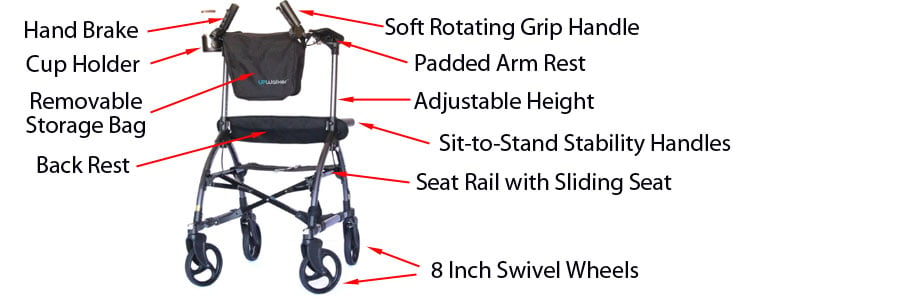
Each UPWalker weighs 25 pounds or less (21 pounds (Small), 23-1/2 pounds (Standard), and 25 pounds (Large)) - light enough to lift onto a threshold. Each unit folds by lifting on the seat and then pushing the sides together. A hook holds the sides in their folded position. When folded, the UPWalker H200S and H200 are small enough to fit into a trunk or back seat for transport. The larger unit (H200L), however, does not fit into all cars. While folded, each stands up for convenient, out-of-the-way storage.
The LifeWalker UPWalker Upright Walker Difference
The base of the unit flows around the user, holding them securely in the center of gravity, with two wheels located in front and two behind. The arrangement distributes weight more evenly from front to back and side to side. Plenty of leg clearance allows for a full step with each stride.
Attention to the little details helps set the UPWalker apart from its competition. Rear-facing reflectors make the ambulistic aid more visible to on-coming traffic. Cupped arm-supports provide comfort and stability. The placement of the handles, along with the brake levers, reduces strain and fatigue. The synergy of the UPWalker design and construction allows the user more freedom to be active and walk farther with less effort.
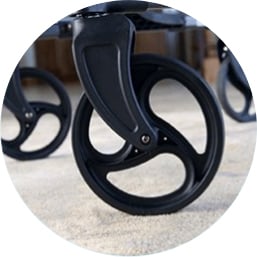
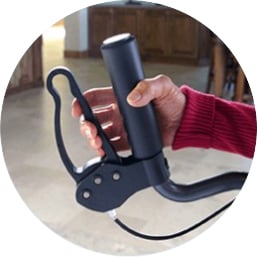

UPWalker Advantages
- Supports Upright Posture
- Walk with Less Pain
- Designed for Stability
- Reduces Safety Risks
- Promotes an Active Lifestyle
- Indoor/Outdoor Compatible
- Adjustable Armrests
- Ergonomic Handbrakes
- Parking Brake
- Fabric Seat with Backrest
- Boosts Agility and Balance
- Folding Frame for Transport
- Sliding Seat for Easy Ingress and Egress
- Increases Freedom
What Comes in the UPWalker Box
- The UPWalker Upright Walker
- A Detachable Bag for Storage
- Cupholder
- Personal Backrest
Stability Designed for Safety
Engineered from the start to be safer, the UPWalker is the only mobility aid that offers enhanced stability and maximum comfort for users. The UPWalker's patented design places the user at the center of gravity - with the weight flows down inside the wheels. Other products shift weight forward over the front wheels instead, causing a tipping hazard.
The UPwalker is the only one of its kind to receive ISO certification for both indoor and outdoor use. Qualifying for the certification requires passing stringent tests that cover the stability of aids that have horizontal arm supports. Competitors fail due to the risk of tipping.
Competing products often come disassembled, requiring assembly. Not only that, but the UPWalker also provides superior comfort features, such as easy height adjustment, ergonomic armrests and brake-handles, and free extras, such as a backrest and beverage holder.
UPWalker Mobility Device Features

UPWalker Features and Benefits
- More Efficient Ambulatory Mechanics
- Less Back Muscle Strain
- 39 to 46 Percent of Body Weight Supported by Armrests
- Less Sway
- Reduces Hunching and Leaning
- Adjustable Height to Create the Optimal Fit
- Ergonomic Bicycle Style Brake Handles
- Lockable Brakes
- Weight Capacity up to 300 Pounds. The Large Unit has a 350 Pound Weight Capacity
- Comfortable Seat
- Easy-to-Control Speed
- Collapsible Frame
- Locking Rings to Indicate Correct Height
UPwalker Specifications
- Product Numbers: H200, H200-S, H200-L
- UPWalker Sizes: Small, Standard, Large
- See the UPWalker Specifications Comparison Chart for dimension details
- Weight: 21 to 25.5 lbs. (depending upon model)
- UPWalker Weight Limit: 300 to 350 lbs. (depending upon model)
- Wheel Size: 8 Inches - All Units
- Brand: UPWalker
- Manufacturer: LifeWalker
- Warranty: Lifetime on Frame, 6-Months on Non-Durable Parts

Product Use Indications
- Seniors
- The elderly
- Those with Parkinson's Disease
- Stroke patients
- CVA
- COPD
- TBI
- Ataxia
- Degenerative Spinal Disease
- Sciatica
- Multiple Sclerosis
- Balance Disorders
- Other Neurological Disorders
- Respiratory Disorders
- Patients in rehab
Product Dimensions
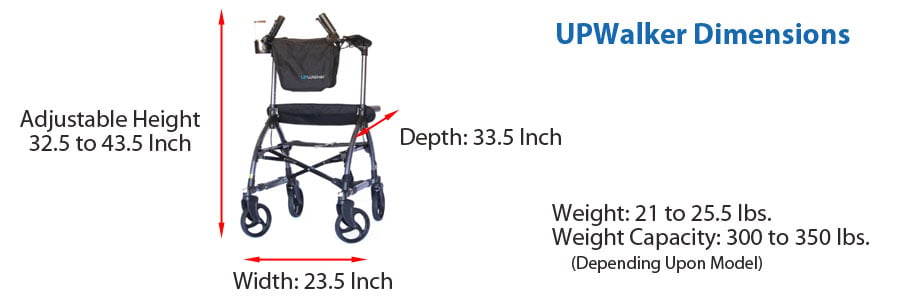
LifeWalker Added Features

Seniors and Mobility Assistance
In a medical study published by the Archives of Physical Medicine and Rehabilitation, researchers found that the UPWalker Stand Up Walker has several postural and metabolic benefits over standard walkers. The UPWalker benefits included helping users to walk more upright rather than slouching over their walker. The users maintained better posture while traversing with the UPWalker. Users exerted less energy and had better endurance with the UPWalker. The LifeWalker product allows users to support some of their body weight on the forearm-support of the UPWalker; thereby, reducing the load upon their wrists and lower back and joints.6
The table below displays the numerous advantages offered by the UPWalker over standard walkers.
Fixing Standard Walker Problems with real solutions from LifeWalker
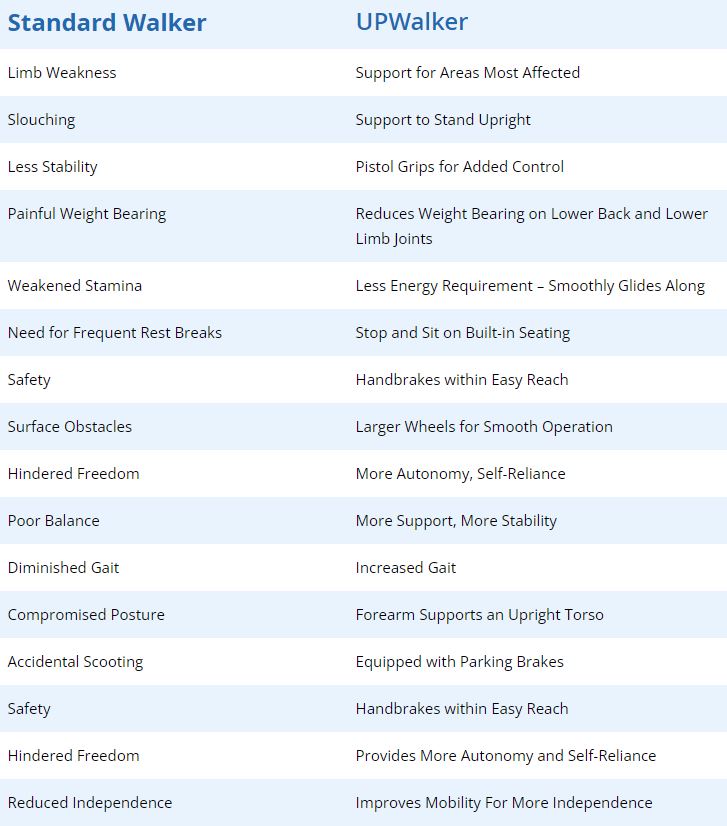
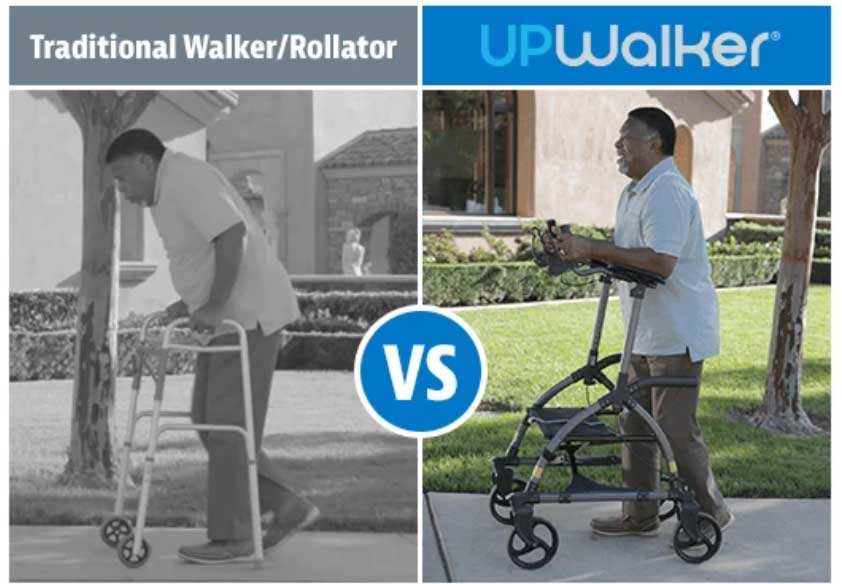
UPWalker Stand Up Walking Aid Directions for Use
- UPWalker For Ambulating
- Adjust arm support height using the white release buttons located just above the seat frame
- Place forearms onto the arm supports.
- Rotate the handgrips to the desired position (many prefer a 45-degree angle).
- Push fingers through the brake handles' openings.
- If the brakes are locked, release them by pulling the brake handles in toward the handles.
- Stand up straight and begin .
- Take regular steps, making sure to bend the knees and toes.
- To brake, squeeze the brake handles.
- *Note each brake handle operates the brake on its side of the aid.
- UPWalker For Sitting
- Push the brake handles forward into their parked position
- Take a step back
- Pull the seat away from the backrest until it can go no further
- Holding the Sit-to-Stand handles of the air, turn around to face away from the device
- Grasp the Sit-to-Stand handles.
- Sit on the seat
- UPWalker from Sitting to Stand
- Check that the parking brakes are on
- Grasp the Sit-to-Stand handles
- Lean forward until the nose is over the toes
- Push upward until standing
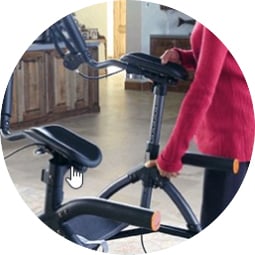
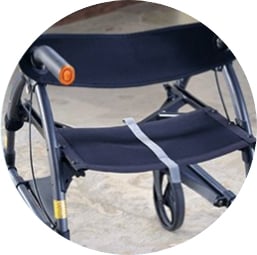
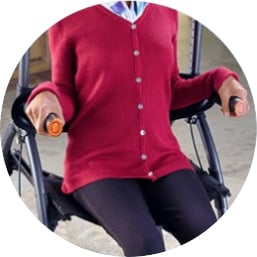
UPWalker Frequently Asked Questions
Does the UPWalker include a seat?
The UPWalker comes with a fabric seat and a comfortable backrest for support.
Does the UPWalker come with a bag/basket?
Yes, it comes with a personal item bag that hooks onto the frame. A large cloth bag with handles for shopping is also available (optional).
How big are the bags on the UPWalker Upright Walking Aid?
The personal item bag is 17 inches (W) by 4 inches (D) by 11 inches (H).
The shopping bag is 18 inches (W) by 11 inches (D) by 12 inches (H).
Does the UPWalker walking aid come with brakes?
The UPWalker has built-in brakes operated by ergonomic handles. One handle works one brake, which stops the rear wheel on that same side as the handle.
Are there parking brakes on the UPWalker?
Pushing the parking brake handles out to the full extension engages the parking brakes.
How does the UPWalker walking aid fit different sized users?
It has adjustable-height armrests to fit different sizes of people.
What is the range of height for the UPWalker?
It accommodates people from 4 feet 7 to 5 feet 10.
Can I use the UPWalker in my home or care center?
Yes. It is safe across floors and maneuvers across many surfaces with ease. It fits through a standard doorway.
Can I use the UPWalker outside?
Yes. It has an ISO certification for outdoor use as well. Use it on concrete, pavement, lawns, graded paths, etc.
Can my doctor prescribe the UPWalker Walking Aid?
A doctor may be able to prescribe it as medically necessary, depending on the situation. Check with a doctor.
UPWalker Dimensions
Handle Height:
(inches):
Accessories for the LifeWalker UPWalker
- Beverage Holder
- Cane/Umbrella Holder
- Smartphone Holder
- Personal Items Bag
- Luxury Item Bag
- Shopping Bag
- Backrest Support
- Flashlight Taillight
UPWalker Walking Aid Manuals and Documents
-
 UPWalker Flyer contains features and benefits.
UPWalker Flyer contains features and benefits. -
 UPWalker Specifications offers product details.
UPWalker Specifications offers product details. -
 User Manual provides product setup and use instructions.
User Manual provides product setup and use instructions.
UPWalker Videos
UPWalker Stand Up Walker Introduction Video (4:17 minutes)
Upright UPWalker for Good Posture Video (2:00 minutes)
Unboxing and Setup of the UPWalker Video (24:55 minutes)
Folding and Transporting the UPWalker Upright Walker Video (0:55 minutes)
Attaching the Backrest Accessory to the Upright UPWalker Video (0:51 minutes)
How to Install the Beverage Holder on the UPWalker Video (1:25 minutes)
Footnotes
- 6 Jayaraman, Chandrasekaran, et al.
Postural and metabolic benefits of using a forearm support walker in older adults with impairments.
Archives of physical medicine and rehabilitation 100.4 (2019): 638-647. (Last Accessed October-2-2020)
Medical Studies
-
 Kim, Oksoo, and Jung?Hee Kim.
Kim, Oksoo, and Jung?Hee Kim. Falls and use of assistive devices in stroke patients with hemiparesis: association with balance ability and fall efficacy.
Rehabilitation nursing 40.4 (2015): 267-274. (Last Accessed October-2-2020) -
 Stowe, S., J. Hopes, and G. Mulley.
Stowe, S., J. Hopes, and G. Mulley. Gerotechnology series: 2. Walking aids.
European Geriatric Medicine 1.2 (2010): 122-127. (Last Accessed October-2-2020) -
 Tagawa, Yoshihiko, et al.
Tagawa, Yoshihiko, et al. Analysis of human abnormal using a multi-body model: joint models for abnormal and aids to reduce compensatory action.
Journal of Biomechanics 33.11 (2000): 1405-1414. (Last Accessed October-2-2020) -
 Ulkar, Blent, et al.
Ulkar, Blent, et al. Energy expenditure of the paraplegic gait: comparison between different aids and normal subjects.
International journal of rehabilitation research 26.3 (2003): 213-217. (Last Accessed October-2-2020)
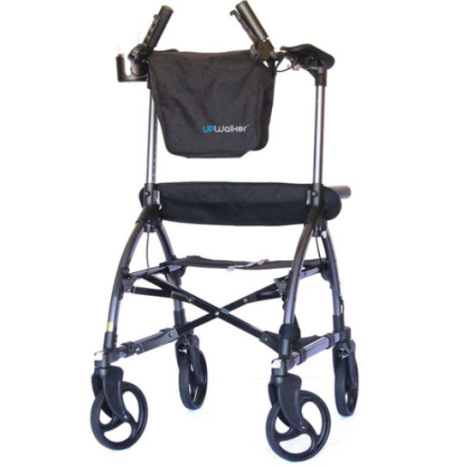

Login and Registration Form